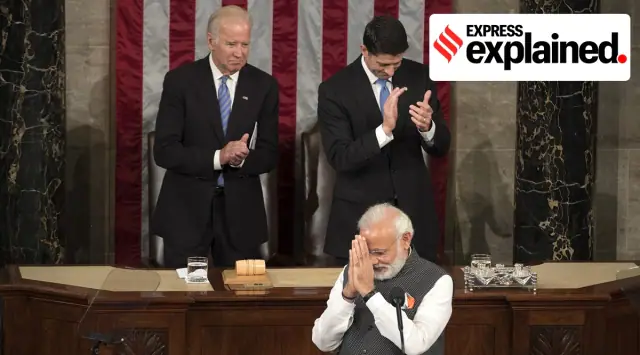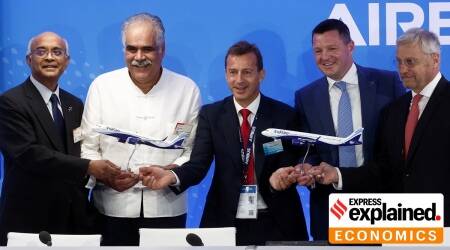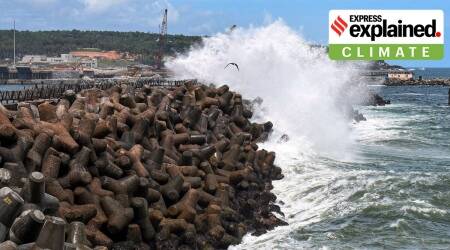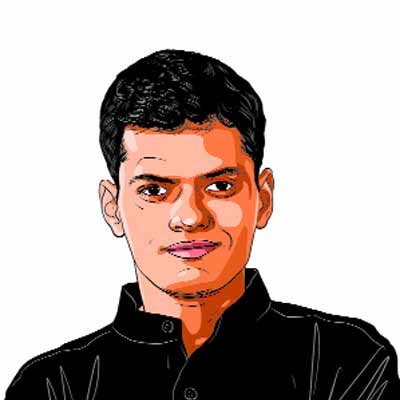India-US: Trust & necessity
Washington's strategic embrace of New Delhi owes both to bilateral efforts and geopolitical concerns. Some divergences remain, but ultimately, mutual interests can be expected to trump other concerns.
 June 8, 2016: Prime Minister Narendra Modi addresses a joint meeting of the US Congress for the first time. Behind him are the leaders of the two chambers, then Vice President Joe Biden and then House Speaker Paul Ryan. (Image source: The New York Times)
June 8, 2016: Prime Minister Narendra Modi addresses a joint meeting of the US Congress for the first time. Behind him are the leaders of the two chambers, then Vice President Joe Biden and then House Speaker Paul Ryan. (Image source: The New York Times) In September 2008, after the Nuclear Suppliers’ Group’s (NSG) waiver to the Indo-US nuclear deal, Prime Minister Manmohan Singh said, “It marks the end of India’s decades long isolation from the nuclear mainstream and technology denial regime.”
In June 2016, Prime Minister Narendra Modi told the US Congress that India and the US have overcome “the hesitations of history”, and called for ever-stronger economic and defence ties.
Six years later, the end of the “technology denial regime” and the overcoming of the “hesitations of history” had developed into the Initiative for Critical and Emerging Technologies (iCET), which President Joe Biden and Prime Minister Modi announced in May 2022.
Led by National Security Advisors Ajit Doval and Jake Sullivan, the initiative got off to a start in January 2023 — and Sullivan visited India this month. The initiative is looking at technologies to be shared in critical sectors such as defence, space, semiconductors, artificial intelligence, and quantum computing.
As Modi lands in the US for his first State Visit — he has travelled to the country seven times as Prime Minister — the initiative on sharing critical and emerging technologies between “trusted geographies” is going to be a key element of the conversation.
Presidents and PMs
The Prime Minister’s visit, in the course of which he will address a joint meeting of Congress for the second time, is a culmination of efforts made by a range of stakeholders over the years. The bilateral relationship has drawn on the current geopolitical situation, US strategic and economic concerns, the political and diplomatic positioning of India, and the slow process of building trust that has overcome the many challenges before the two democracies.
After the nuclear tests of 1998, Prime Minister Atal Bihari Vajpayee faced global opprobrium, but he explained India’s position in a letter written to President Bill Clinton. “We have an overt nuclear weapon state on our borders, a state which committed armed aggression against India in 1962,” Vajpayee said. “Although our relations with that country have improved…an atmosphere of distrust persists mainly due to the unresolved border problem.”
While “the nuclear tests…may have retarded India’s relationship with the US and the West somewhat, by the turn of the century, [it had]…begun to crystallize into a mutually beneficial and substantive relationship”, former Foreign Secretary Shyam Saran wrote in his book, How India Sees the World
The Jaswant Singh-Strobe Talbott talks led to President Clinton’s visit in March 2000, and in the years that followed, relationship strengthened and matured. The George W Bush years saw the Indo-US nuclear deal, which elevated ties to a higher strategic trajectory. That the US pulled all the levers — including a phone call between President Bush and China’s President Hu Jintao — is testimony to Washington’s strategic embrace of New Delhi.
In the last months of Bush’s tenure, the global financial crisis hit, and the 26/11 terrorist attacks on Mumbai followed soon afterward.
Ties stayed the course under Barack Obama, who became the only President to visit India twice, and who hosted both Prime Ministers Singh and Modi at the White House. And despite Donald Trump’s unpredictability, ties continued to strengthen during his presidency.
The Quad framework was revived, and the defence partnership was strengthened with the signing of the foundational agreements. Trump visited India just before the Covid-19 pandemic put much of the world under lockdowns.
Ties have maintained their rhythm under President Biden, especially on the Indo-Pacific strategy. But the chaotic US exit from Afghanistan left New Delhi vulnerable at a time when India faced challenges along two of its borders.
A special friendship
“India’s relationship with the US has been the most comprehensive association the country has had since independence…this is truly a relationship forged in crisis”, Rudra Chaudhuri, head of Carnegie India, wrote in his book, Forged in Crisis: India and the US since 1947.
Shyam Saran told The Indian Express at an Idea Exchange programme in May 2022: “The kind of depth and breadth that the India-US relationship has acquired in the last couple of decades, …to me, has been a very surprising development. If you told me in 2005 that 20 years later, we would have such a strong military-to-military relationship, a strong counter-terrorism relationship, I would have probably said that that is an unrealistic prospect. But that has happened. I would have been one of the persons to oppose the signing of all the three foundational agreements between India and the United States. But there is a recognition that in terms of the challenges that we face, and will continue to face, this relationship is going to be very critical. And I agree with that.”
Saran was referring to the defence agreements that have been signed to provide the legal framework for enhanced interaction and exchange of information between the two militaries. These are the Logistics Exchange Memorandum of Agreement (LEMOA, 2016); Communications Compatibility and Security Agreement (COMCASA, 2018); and Basic Exchange and Cooperation Agreement (BECA, 2020).
LEMOA allows the two militaries to access supplies, spare parts, and services at each other’s bases. COMCASA allows the US to provide India with its encrypted communications equipment and systems so that Indian and US military commanders, aircraft and ships can communicate with each other through secure networks in peace and war. And BECA allowed India to use US geospatial intelligence and enhance accuracy of automated systems and weapons like missiles and armed drones.
Other defence pacts were also signed: Industrial Security Agreement (ISA, 2019), and Memorandum of Intent on Defence Innovation Cooperation (2018). The India-US Defence Industrial Cooperation Roadmap, concluded during the visit of Defense Secretary Lloyd J Austin last month, is expected to fast-track technology cooperation and co-production in areas of mutual interest. It is expected to be announced during Modi’s visit, officials have indicated.
Russia and China
While enough strategic trust has been built over time for the two countries to consider the transfer of about 11 critical technologies in the GE414 engine deal, there have been challenges in their divergent approaches towards Russia.
The Russian invasion of Ukraine has tested the durability of the relationship like never before.
Over the last 16 months, India has not criticised Russia’s actions — much to the discomfiture of its allies in Europe and the US. So when Prime Minister Modi told President Vladimir Putin in September last year that “today’s era is not of war”, the US was pleased — both with the formulation and its articulation in public.
At the same time, Washington has shown an understanding for India’s complex ties with Russia — its more than 60% dependence on Russian defence supplies, and its purchase of Russian oil at cheaper rates.
Both countries acknowledge Beijing as the biggest threat and rival. New Delhi had seen the challenge from far, but US administrations had ignored the warning signs until Obama started talking about the concept of “pivot”. But it was only under Trump that the US unambiguously identified China as a strategic threat. This framing has continued under President Biden.
With the US exit from Afghanistan, Beijing’s stock in the region has risen. And the ambition and confidence behind China’s efforts at making peace between the Saudis and Iranians, Israel and Palestine, Russia and Ukraine has been noticed in Washington and New Delhi.
With Russia and China having announced no-limits ties, India and the US have found reasons for greater convergence in approach: the Quad grouping and I2U2 formats are reflections of those.
The upshot
Divergences remain — Democrats have always been vocal about human rights, freedom of press, and rights of minorities, while New Delhi has pushed back against interference in “India’s internal matters”.
But ultimately, interests trump other concerns — and New Delhi is aware of that. India has positioned itself as a fellow democracy and a strategic counterweight to China.
So, as the red carpet is laid out for Modi — with a State dinner hosted by President Biden and First Lady Jill Biden, a lunch hosted jointly by Vice President Kamala Harris and Secretary of State Antony Blinken, a reception by top US Congress lawmakers — Foreign Secretary Vinay Kwatra said, “This is a milestone in our relationship between the two countries…it’s a very significant visit, very important visit, a visit on which there is a genuine and widespread deep interest in the United States.”







































